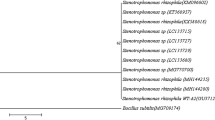Abstract
In our study, the potential of producing polyhydroxybutyrate (PHB) by cultivating fast-growing rhizobia (Sinorhizobium meliloti, Rhizobium leguminosarum bv. viciae, R. leguminosarum bv. phaseoli and R. leguminosarum bv. trifolii) in sludge and in industrial wastewater was evaluated. Results confirmed the possibility of using sludge as media for rhizobial growth. During growth, substantial quantity of PHB was accumulated and yields varied depending on the media and rhizobial species. Growing in sludge, PHB production did not exceed 3.7% w/w for all strains at the end of experiment (after 72 h). During the growth of S. meliloti, PHB yield varied and the maximum value reached 7.27% w/w after 60 h, with 1% Total Suspend Solid (TSS) sludge. Alkaline sludge pre-treatment affects rhizobial growth but did not improve the PHB accumulation. While growing S. meliloti in industrial wastewater, the PHB yields varied and the highest value was obtained with slaughterhouse wastewater (10.7% w/w) after 35 h of growth. Therefore, this work shows the potential of exploiting PHB production by rhizobia growing in wastewater or sludge which could be applied to bioplastic industry, and confirms the potential of these recyclable wastes for high production of rhizobial cells useable for legumes inoculants production. This study provides an environmentally sound way of sludge and wastewater management and use in diverse biotechnological applications.



Similar content being viewed by others
References
Ben Rebah, F., Tyagi, R. D., Filali-Meknassi, Y., & Surampalli, R. Y. (2004). Bacterial productions of bioplastics in advances in water and wastewater treatment. American Society of Civil Engineers (ASCE), 42–71.
Fiechter, A. (1990). Plastics from bacteria and for bacteria. In Poly (β-hydroxyalkanoates) as natural, biocompatible, and biodegradable polyesters (pp. 77–93). New York: Springer.
Hayaward, A. C., Forsyth, W. G. C., & Roberts, J. B. (1959). Synthesis and breakdown of poly-β-hydroxybutyric acid by bacteria. Journal of General Microbiology, 20(3), 510–518.
Vincent, J. M., Humphrey, B., & North, J. (1962). Some features of the fine structure and chemical composition of Rhizobium trifolii. Journal of General Microbiology, 29(3), 551–555.
Steinbuchel, A., Haywood, G. W., Anderson, A. J., Williams, D. R., Dawes, E. A., & Ewing, D. F. (1991). Accumulation of a poly(hydroxyalkanoate) copolymer containing primarily 3-hydroxyvalerate from simple carbohydrate substrates by Rhodococcus sp. NCIMB 40126. International Journal of Biological Macromolecules, 13(2), 83–88. doi:10.1016/0141-8130(91)90053-W.
Choi, J., & Lee, S. Y. (1997). Process analysis and economic evaluation for poly (3-hydroxybutyrate) production by fermentation. Bioprocess Engineering, 17(6), 335–342. doi:10.1007/s004490050394.
Yu, P. H. F., Chua, H., Huang, A. L., Lo, W. H., & Ho, K. P. (1999). Transformation of industrial food waste into polyhydroxyalkanoates. Water Science and Technology, 40(1), 365–370. doi:10.1016/S0273-1223(99)00402-3.
Dave, H., Ramakrishna, C., & Desai, J. D. (1996). Production of polyhydroxybutyrate by petrochemical activated sludge and Bacillus sp. IPCB-403. Indian Journal of Experimental Biology, 34(3), 216–219.
Ben Rebah, F., Prevost, D., Yezza, A., & Tyagi, R. D. (2007). Agro-industrial waste materials and wastewater sludge for rhizobial inoculant production: a review. Bioresource Technology, 98(18), 3535–3546. doi:10.1016/j.biortech.2006.11.066.
APHA American Public Health Association (1992). Standard methods for examination of water and wastewater (18th ed.). Washington, D.C.: American Public Health Association.
Comeau, Y., Hall, K., & Oldham, W. K. (1988). Determination of poly-β-hydroxyvalerate in activated sludge by gas–liquid chromatography. Applied and Environmental Microbiology, 54(9), 2325–2327.
Ben Rebah, F., Tyagi, R. D., & Prevost, D. (2001). Acid and alkaline treatments for enhancing the growth of rhizobia in sludge. Canadian Journal of Microbiology, 47(6), 467–474. doi:10.1139/cjm-47-6-467.
Ben Rebah, F., Tyagi, R. D., Prevost, D., & Surampalli, R. Y. (2002). Wastewater sludge as a new medium for rhizobial growth. Water Quality Research Journal of Canada, 37(2), 353–370.
Ben Rebah, F., Prevost, D., & Tyagi, R. D. (2002). Growth of alfalfa in sludge-amended soils and inoculated with rhizobia produced in sludge. Journal of Environmental Quality, 31(4), 1339–1348.
Ben Rebah, F., Tyagi, R. D., & Prevost, D. (2002). Production of Sinorhizobium meliloti using wastewater sludge as a raw material: effect of nutrient addition and pH control. Environmental Technology, 23(6), 623–629. doi:10.1080/09593332308618378.
Ben Rebah, F., Tyagi, R. D., & Prevost, D. (2002). Wastewater sludge as a substrate for growth and carrier for rhizobia: the effect of storage conditions on survival of Sinorhizobium meliloti. Bioresource Technology, 83(2), 145–151. doi:10.1016/S0960-8524(01)00202-4.
Nair, S., Jha, P. K., & Babu, C. R. (1993). Variation in poly-β-hydroxybutyrate synthesis in rhizobia reflects strain differentiation and temperature regulation. Journal of Basic Microbiology, 33(1), 35–39. doi:10.1002/jobm.3620330107.
Mercan, N., Aslim, B., Yuksekdag, N., & Beyatli, Y. (2002). Production of poly-β-hydroxybutyrate (PHB) by some Rhizobium bacteria. Turkish Journal of Biology, 26(4), 215–219.
Tavernier, P., Portais, J. C., Saucedo, J. E. N., Courtois, J., Courtois, B., & Barbotin, J. N. (1997). Exoploysaccharide and poly-β-hydroxybutyrate coproduction in two Rhizobium meliloti strains. Applied and Environmental Microbiology, 63(1), 21–26.
Halder, A. K., & Chakrabartty, P. K. (1995). Constitutive nitrate and nitrite reductase activities of Rhizobium in relation to denitrification. Journal of Basic Microbiology, 35(4), 233–239. doi:10.1002/jobm.3620350407.
Author information
Authors and Affiliations
Corresponding author
Rights and permissions
About this article
Cite this article
Ben Rebah, F., Prévost, D., Tyagi, R.D. et al. Poly-β-hydroxybutyrate Production by Fast-Growing Rhizobia Cultivated in Sludge and in Industrial Wastewater. Appl Biochem Biotechnol 158, 155–163 (2009). https://doi.org/10.1007/s12010-008-8358-1
Received:
Accepted:
Published:
Issue Date:
DOI: https://doi.org/10.1007/s12010-008-8358-1




